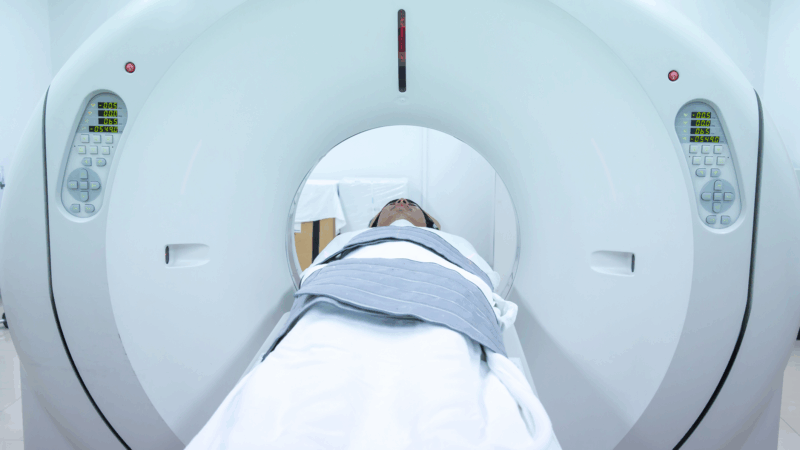Study highlights cancer risk from millions of CT scans performed annually
CT scans diagnose afflictions from tumors to kidney stones to life-threatening diseases and injuries, such as aneurysms and blood clots leading to stroke.
But the radiation emitted by this essential diagnostic tool may cause more harm than previously known and could eventually be responsible for roughly 5% of all cancers diagnosed in the U.S. in a single year, a new study finds.
“Medical imaging has potential benefits,” said radiologist Dr. Rebecca Smith-Bindman, an epidemiology professor at the University of California, San Francisco, and lead author of the study published Monday in JAMA Internal Medicine. “It has potential harms as well, and it’s really important to balance them.”
Scientists long ago established that ionizing radiation emitted by computed tomography, or CT, scans increases cancer risk. But, since 2007, use of the imaging technique has surged 35%, the study says, due in part to growth in what Smith-Bindman and her colleagues call “low-value, potentially unnecessary imaging.”
Their new research, based on projections from hospitals in 20 U.S. states, estimates that 103,000 cancer diagnoses, or 5% of all cancers, could result from 93 million scans performed in the U.S. in 2023 alone.
“There’s nothing you can do about radiation that you’ve been exposed to already. But you want to limit future exposure to cases when you really need it,” Smith-Bindman said.
Some scans might add no diagnostic value, she said. Moreover, the amount of radiation a scan emits fluctuates widely and can be far higher than necessary with the operator, not the machine, making the difference, she said. The dose at one scanning facility can be 50 times stronger than at another.
Dr. Dana Smetherman, chief executive officer of the American College of Radiologists, praised the study for bringing awareness to the question of radiation risk. Some people are unaware, for example, that ultrasounds and MRIs do not emit radiation and that CT scans do, she said.
“As radiologists, we always want patients to be informed and feel comfortable asking the questions, ‘tell me more about this test, what’s involved, what’s it going to show you?’ ” said Smetherman, who was not involved with the research.
Echoing a statement from the American College of Radiology after the study’s release, she stressed that the study’s projection of cancer diagnoses from CT scans was based on statistical modeling, not actual patient outcomes.
There are no published studies directly linking CT scans to cancer, the statement says. “Americans should not forgo necessary, life-saving medical imaging and continue to discuss the benefits and risks of these exams with their healthcare providers,” it continues.
CT scans use ionizing radiation to create cross-sectional pictures inside the body. The scans can reveal more detail than conventional X-rays and are accurate, quick and relatively inexpensive.
Nationally, the new cancer projections from CT scans put them on par with other well-known, population-wide risk factors for cancers, like alcohol and obesity, an editor’s note accompanying the study points out. Cigarette smoking remains the leading contributor to U.S. cancers, causing 19% of them, followed by excess body weight at 7.6% and alcohol consumption at 5%, Smith-Bindman said.
To curtail radiation exposure, authors of the study and the editorial urge changes to current practices.
The surest way to eliminate exposure to radiation from CT scans is to stop doing the low-value ones. Yet efforts to restrict them, including an initiative from the American Board of Internal Medicine Foundation called Choosing Wisely that launched in 2012, have fallen short, Smith-Bindman said.
She believes the greatest opportunity to reduce risk from CT scans is to optimize the dose used in each scan.
“We can absolutely try to reduce all those excessive doses,” she said. “We need buy-in from physicians and hospitals.”
She says patients can try to reduce their cancer risk by discussing with their doctors how important it is to get any particular scan and how they might receive as small a dose of radiation from a scan as necessary.
The University of California, San Francisco, hosts a website called Know Your Dose in an effort to empower patients to ask questions about how much radiation they’re getting from scans.
A brain scan, the website shows, can emit as little radiation as 200 dental X-rays or as much as 1,600. The radiation dose from an abdominal scan for a suspected kidney stone can be as low as 100 dental X-rays or as high as 8,000. Kidney stones also sometimes can be diagnosed with ultrasound, which does not emit radiation, the website notes.
One of the reasons for the striking differences in radiation emissions is that sometimes patients are scanned just once, and other times they’re scanned multiple times. Multiple images often are unnecessary, Smith-Bindman said.
Though she and others have been pushing for federal standards for dosages, there are none.
Under a Medicare measurement tool released in January, hospitals and imaging facilities share information about how much radiation their scanners emit. Based upon the information, Smith-Bindman and her colleagues are developing a quality measure for CT scanning. So far, she said, one-third of scans exceed the targets in their testing.
“We need patients to ask their doctors, ‘Can you use low dose when you scan me?’ ” Smith-Bindman said. “It’s crazy that patients have to ask for it, but it’s actually really successful.”
Ronnie Cohen is a freelance writer in the San Francisco Bay Area.
Light from satellites will ruin majority of some space telescope images, study says
Astronomers have long been concerned about reflections from satellites showing up in images taken by telescopes and other scientific instruments.
Defense Department is reviewing boat strike video for possible release, Hegseth says
In a speech on Saturday, Defense Secretary Pete Hegseth defended the strikes, saying: "President Trump can and will take decisive military action as he sees fit to defend our nation's interests."
Bama, Miami in, Notre Dame out and Indiana No. 1 in College Football Playoff rankings
Nobody paying attention for the past 24 months would be surprised to see Indiana – yes, Indiana – leading the way into this year's College Football Playoff.
McLaren’s Lando Norris wins first F1 title at season-ending Abu Dhabi Grand Prix
Red Bull driver and defending champion Max Verstappen won the race with Norris placing third, which allowed Norris to finish two points ahead of Verstappen in the season-long standings.
A ban on feeding pigeons ruffles lots of feathers in Mumbai
The pigeon population has exploded — a result of people feeding the birds. For some it's a holy duty and a way to connect to nature. Critics point to health risks tied to exposure to pigeon droppings.
UN humanitarian chief: world needs to ‘wake up’ and help stop violence in Sudan
The UN's top humanitarian and emergency relief official has told NPR that the lack of attention from world leaders to the war in Sudan is the "billion dollar question".








